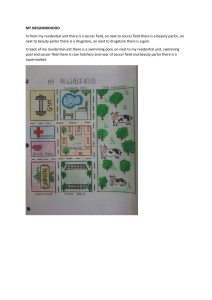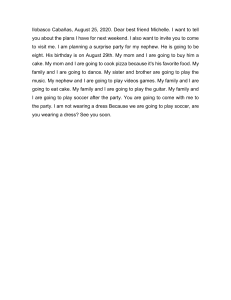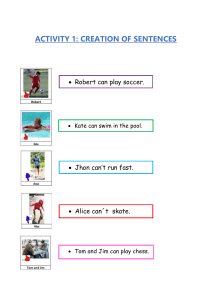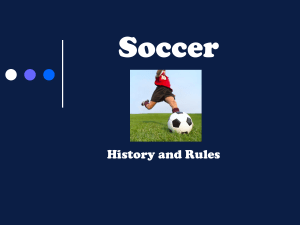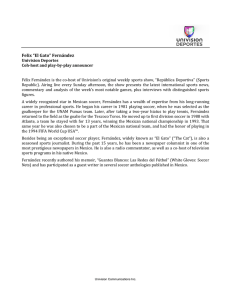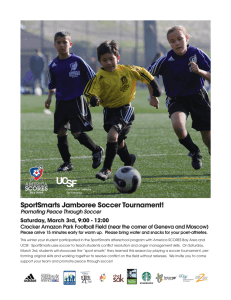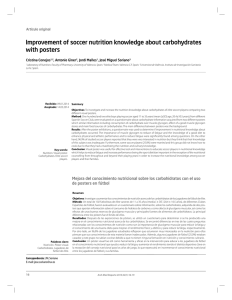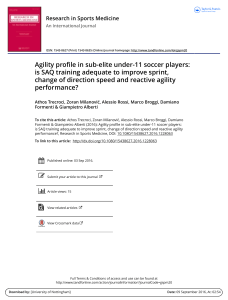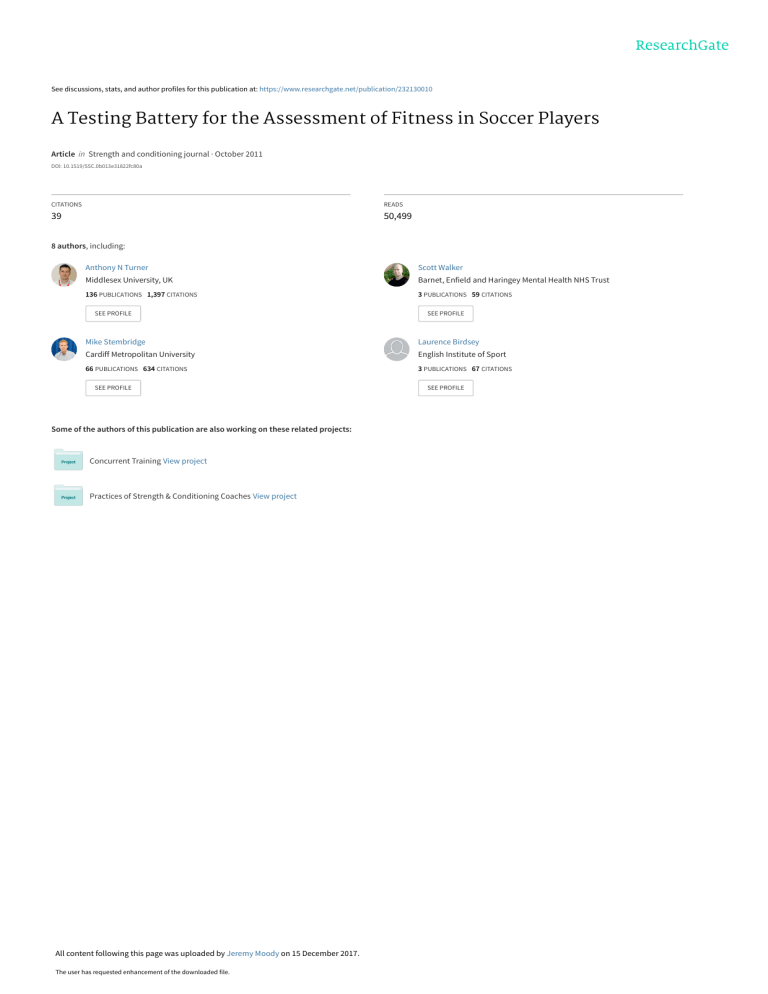
See discussions, stats, and author profiles for this publication at: https://www.researchgate.net/publication/232130010 A Testing Battery for the Assessment of Fitness in Soccer Players Article in Strength and conditioning journal · October 2011 DOI: 10.1519/SSC.0b013e31822fc80a CITATIONS READS 39 50,499 8 authors, including: Anthony N Turner Scott Walker Middlesex University, UK Barnet, Enfield and Haringey Mental Health NHS Trust 136 PUBLICATIONS 1,397 CITATIONS 3 PUBLICATIONS 59 CITATIONS SEE PROFILE SEE PROFILE Mike Stembridge Laurence Birdsey Cardiff Metropolitan University English Institute of Sport 66 PUBLICATIONS 634 CITATIONS 3 PUBLICATIONS 67 CITATIONS SEE PROFILE Some of the authors of this publication are also working on these related projects: Concurrent Training View project Practices of Strength & Conditioning Coaches View project All content following this page was uploaded by Jeremy Moody on 15 December 2017. The user has requested enhancement of the downloaded file. SEE PROFILE A Testing Battery for the Assessment of Fitness in Soccer Players Anthony Turner, MSc, CSCS,1 Scott Walker, MSc, CSCS,1 Michael Stembridge, MSc,2 Paul Coneyworth, MSc,1 Glen Reed, MSc,1 Laurence Birdsey, MSc,2 Phil Barter, MSc,1 and Jeremy Moody, PhD2 1 London Sport Institute, Middlesex University, London, United Kingdom; and 2Cardiff School of Sport, University of Wales, Cardiff, United Kingdom SUMMARY STRENGTH AND CONDITIONING PROFESSIONALS WORKING WITH SOCCER TEAMS MUST BE ABLE TO ADMINISTER A TIME-EFFICIENT, VALID, AND RELIABLE FITNESS TEST, WITH HIGH CONTENT VALIDITY. BASED ON THESE CRITERIA AND THE RESEARCH HEREIN, THE FOLLOWING BATTERY IS ADVISED: ANTHROPOMETRY, SQUAT JUMP, COUNTER MOVEMENT JUMP, REACTIVE STRENGTH, 1 REPETITION MAXIMUM (1RM) POWER CLEAN, 1RM SQUAT, PRO-AGILITY, LINEAR SPEED, AND YO-YO INTERMITTENT RECOVERY TEST. THE RESULTS CAN GUIDE THE STRENGTH AND CONDITIONING PROFESSIONALS AND TECHNICAL COACHES IN PROGRAM DESIGN, LEADING TO MORE EFFECTIVE AND EFFICIENT GOAL ACHIEVEMENT. INTRODUCTION t is considered essential that fitness testing be administered before an athlete begins a strength and conditioning program and/or competitive season. Testing sessions using the same battery should then be re-administered systematically throughout the training phases of the season to assess progress and make program alterations where needed. When conducting testing within the competitive season, it is prudent to do so on a day which does I not fall within 2 days of a competition, either before or after, to prevent fatigue affecting either the testing results or the game performance. The purpose of this article is to provide the strength and conditioning professionals with evidence-based information permitting the effective implementation of an appropriate test battery of soccerspecific fitness tests. Initially, this article will deal with the rationale for fitness testing and will be specifically aimed at non–laboratory-based tests. Various field tests, which assess the different components of fitness reported as specific to soccer, will then be described and appraised. Finally, a rationale for the choice of recommended tests will be reasoned and a timeline for implementation will be outlined. NEEDS ANALYSIS: WHAT SHOULD BE TESTED? As with any sport to which a fitness battery is to be implemented, the strength and conditioning professionals must first undergo a needs analysis to identify the biomechanical and physiological requirements of the sport. Only after this, can an efficacious testing battery be formulated. AEROBIC CAPACITY Various physiological parameters have been shown to have strong correlations with soccer performance. As Castagna et al. (12) reported, it has been shown repeatedly, through descriptive, cross-sectional, and training _ 2max, studies, that aerobic fitness (Vo lactate/anaerobic threshold, and running Copyright Ó National Strength and Conditioning Association economy) is positively related to soccer performance outcomes in terms of an individual’s match statistics. This would include parameters such as distance covered, time on the ball, and number of sprints during a match (12,16,34,42). Aerobic capacity is also correlated with the overall success of a team in terms of final standing in the league (80), level within the association the team plays (3,58) and whether the player is a reserve or starter (71,28). Specifically, Helgerud et al. (32) reported that an enhanced aerobic capacity (from 58.1 6 4.5 mL/kg/min to 64.3 6 3.9 mL/kg/min; p , 0.01) in soccer players improved match performance by increasing the distance covered by 20% (p , 0.01), enhanced the average work intensity (from 82.7 6 3.4% to 85.6 6 3.1%; p , 0.05), increased the number of sprints by 100% (p , 0.01), improved lactate threshold (from 47.8 6 5.3 mL/kg/min to 55.4 6 4.1 mL/kg/min; p , 0.01) and running economy (by 6.7%; p , 0.05), and increased the number of involvements with the ball by 24% (p , 0.05). Castagna et al. (12) states that monitoring aerobic fitness on a regular basis is important for assessing the effectiveness of a physical training program and the preparedness of soccer players to compete. Table 1 identifies position-specific values for aerobic capacity in elite-level soccer players. KEY WORDS: soccer; fitness; testing Strength and Conditioning Journal | www.nsca-lift.org 29 Fitness Testing for Soccer Table 1 Physiological characteristics of elite Croatian soccer players Variable Defenders (n = 80) Midfielders (n = 80) Attackers (n = 80) Goalkeepers (n = 30) Total (N = 270) Range Body fat (%) 12.2 6 0.7 8.4 6 2.9 10.2 6 2.1 14.2 6 1.9 11.96 3.1 6.3–19.5 5 m (s) 1.43 6 0.5 1.47 6 0.6 1.39 6 0.4 1.45 6 0.7 1.44 6 0.5 1.39–0.47 10 m (s) 2.14 6 0.7 2.23 6 0.5 2.03 6 0.9 2.35 6 0.8 2.27 6 0.4 2.13–2.36 SJ (cm) 42.3 6 2.1 41.49 6 4.0 44.2 6 3.2 46.8 6 1.4 44.1 6 1.3 40.9–48.3 CMJ (cm) 44.2 6 1.9 44.26 6 2.1 45.3 6 3.2 48.5 6 1.5 45.1 6 1.7 41.4–50.1 V_ O2max (mL/kg/min) 59.2 6 1.5 62.3 6 3.1 58.9 6 2.1 50.5 6 2.7 60.1 6 2.3 50.3–65.3 187.2 6 2.3 191.1 6 2.1 188.1 6 2.1 188.5 6 1.9 189.1 6 1.9 185.4–193.3 HRmax (beats/min) Information attained from Sporis et al. (64). CMJ = countermovement jump; SJ = squat jump; HRmax = heart rate max. ACCELERATION, SPEED, AND SPEED-ENDURANCE Sprinting ability is an integral component of successful performance in a variety of sports and the ability to accelerate in soccer underlies successful game play (40,47). Straight-line sprinting can be broken down into 3 phases: acceleration, attainment of maximal speed, and maintenance of maximal speed or speed-endurance (17,46). These are distinct qualities of speed, and specific tests should be used to evaluate each component within an appropriate test battery. At the elite level, soccer is also characterized by brief periods of intense activity followed by periods of recovery (10,38,39). These brief periods can be the actions that dictate the winning and losing team (40,51). Therefore, players must be able to perform these intense tasks repeatedly, and it is thus possible to state, with confidence, that the greater the ability of a player to restore depleted adenosine triphosphate (ATP) and phophocreatine (PCr) stores, the closer to maximal performance the subsequent sprint will be (5,61). AGILITY Mirkov et al. (44) examined the reliability of soccer-specific field tests and reported that the most appropriate indicator of overall soccer 30 performance may be agility testing. Agility is defined as the ability to change direction rapidly, without losing balance, using a combination of strength, power, and neuromuscular coordination (40,61,84). Young et al. (83) and Sheppard and Young (62) also suggest that agility is further affected by the athlete’s perceptual and decision-making skills. Agility constitutes around 11% of player movement (40,44,45,65), and on average, a player will make 50 turns during a single match (81). Previous literature, however, suggests that a soccer player changes direction every 2–4 seconds (73) and makes 1,200– 1,400 changes (7) of direction during a game. This discrepancy is likely based on the definition of terms, but nevertheless, rapid activity occurs in the crucial seconds of the game and can make the difference between scoring and conceding a goal (18,37,40). Thus, the ability to produce fast-paced variable actions can impact soccer performance (40), and therefore, a soccer player’s agility must be assessed. STRENGTH AND POWER Soccer requires repeated powerful movements like kicking, sprinting, tackling, and jumping. Measures of power generation, including sprinting ability (37,40,57) and jumping height and distance (14,57), have been shown VOLUME 33 | NUMBER 5 | OCTOBER 2011 to be positively correlated to performance in soccer. It is therefore of vital importance to measure a player’s speed, power generation capacity and reactive strength ability, or stretchshortening cycle (SSC) augmentation. Power is largely dependent on the ability to exert the highest possible force (i.e., maximum strength) (66,67). For example, significant correlations have been found between 1 repetition maximum (1RM) squat relative to body mass and countermovement jump (CMJ) peak power, CMJ peak velocity, and CMJ height (49). This is further corroborated by Peterson et al. (53) who found significant linear relationships among the 1RM squat, vertical jump peak power, and all explosive performance tests (vertical jump, broad jump, agility t test, sprint acceleration, and sprint velocity). In summation, it is therefore equally important to assess a player’s strength. REACTIVE STRENGTH An enhanced reactive strength ability results in an increased jump height and hopping height (2,21), a reduced ground contact time at all running speeds (2), and an increased rate of force development (9,79) and contributes to an athlete’s ability to change direction (26,83). In addition, Voigt et al. (76) and Verkhoshansky (74) reported that economical sprinting, that is, the efficient usage of the stretch-shortening mechanism, can recover approximately 60% of the total mechanical energy, thereby increasing running economy. This should be considered fundamental due to the _ 2max significant contribution a high Vo makes to a players’ game, of which running economy is a fundamental component (16,41). An athlete’s reactive strength ability is therefore essential to many key movements within soccer, and thus this parameter should also be assessed as part of an appropriate test battery. WHY FIELD TEST? Logistically, it is very difficult to get an athlete or a team of athletes to a testing laboratory. Laboratory tests are often very expensive, thus making them inaccessible for regular use even for clubs with sound financial backing. These inhibitory factors have lead to the design of valid and reliable field tests. In further support, coaches have less than a month of preseason in some cases, before the season officially begins. It is important that assessments are administered in a timely manner without compromising reliability and validity and ensuring each player has a sufficient amount of recovery between each test. Field tests are better suited for such goals and popular with both coaches and players because of their simplicity, time efficiency, and lack of equipment required. SEQUENCE OF TESTING Knowledge of exercise physiology helps guide the order of tests and the duration of rest periods between tests to ensure reliability (29). Testing tasks which are highly skillful, such as those which require coordinated movements and an attention to ‘‘form,’’ should be conducted before performance tests inducing fatigue in order that the latter do not distort the results (29). The National Strength and Conditioning Association (NSCA) (29) suggests the following order: resting and nonfatiguing (resting heart rate, body composition, flexibility and jump tests), agility, power and strength, sprints, local muscular endurance, anaerobic capacity and aerobic capacity tests. When considering the rest periods between tests, the strength and conditioning professionals should be guided by the time course for restoration of key metabolic substrates. For example, Hultman et al. (36) suggest that approximately 70% ATP restoration occurs in around 30s, whereas 3–5 minutes of recovery is needed to completely resynthesize ATP. In addition, it has been reported that approximately 84% of PCr stores are restored in 2 minutes, 89% in 4 minutes, and 100% in 8 minutes (31,35,36). Therefore, for power tests lasting around 1 second (e.g., the power clean and CMJ) and strength and speed tests lasting around 4 seconds (e.g., the 1RM back squat and 30-m sprint), 3–5 minutes between trials may be required because these depend on intramuscular stores of ATP. However, for longer lasting tests, for example, repeated sprint tests, which also tax intramuscular stores of PCr, 8 minutes between repetitions/ tests may be warranted. test also consists of a 20-m shuttle run, but after 2 lengths (out and back), the subjects have a recovery period. There are 2 versions of the Yo-Yo intermittent test. The Yo-Yo intermittent endurance (YYIE) test allows a recovery period of 5 seconds and the Yo-Yo intermittent recovery (YYIR) test allows 10 seconds. Two difficulty levels for each test have been developed. The Yo-Yo tests are designed to assess the athletes’ capacity to exercise intensely and intermittently over a long period. The tests stress the phosphagen and glycolytic energy systems, thus providing an appropriate representation of a soccer match (61,68). In a review by Walker and Turner (77), it was concluded that YYIE tests are more aerobic related, whereas YYIR tests are aerobic-anaerobic related, and thus, the latter is most appropriate. Furthermore, younger athletes and those with a lower training age would be recommended to undergo the YYIE level 1 test and progress through to level 2. Elite athletes, with a high training age, are recommended to be tested with the YYIR level 2 (10,38,39). FIELD-BASED TESTS SPEED TESTS Aerobic tests Several field tests for aerobic capacity have been developed that require the subject to either cover a maximal distance in a set time or a set distance in the fastest time possible. These tests are maximal from the beginning and require a high degree of motivation and knowledge of pacing to achieve a reliable result. Due to the significance of pacing skills, tests depending on this ability, such as the 1.5-mile run and the 12-minute run, may not be the most appropriate tests for soccer players because these possibly require lengthy familiarization periods due to an inherent learning effect. Bangsbo (6) found players sprint between 1.5 m and the length of the field during a match, but average 17 m. Around 96% of sprints are less than 30 m, with an average duration of less than 6 seconds and an occurrence of every 90 seconds (6). This is in general agreement with other authors in the field who report that almost half of the sprints are less than 10 m (44,65). Furthermore, maximal sprints are often commenced when the player is already in motion so maximal velocity is achievable in a reduced period of time and distance (40,61). This therefore suggests the necessity to measure speed after a flying/rolling start. Fortunately, a range of beep tests are available, and these negate the need for athletes to self-pace. Although the 20-m shuttle run test is arguably the most renowned beep test aimed at predicting aerobic capacity, a soccer-specific 20-m shuttle run test, the Yo-Yo intermittent test, is often advised for soccer (77). This The time taken to complete a 5- to 10-m sprint from a stationary start is well accepted as a valid and reliable test to measure acceleration and is specific to soccer as aforementioned. Different protocols have been used to analyze maximal speed but most involve linear running over a distance between 5 Strength and Conditioning Journal | www.nsca-lift.org 31 Fitness Testing for Soccer and 40 m or more than 40 yd (15,40,44,61,69). This however, is not entirely specific to field sports so most also measured maximal speed from a rolling start (15,40,44,61). Table 1 illustrates position-specific sprint times (5 and 10 m) in elite-level soccer players. In terms of efficiency, it may be more appropriate to measure acceleration and maximal speed during the same trial by recording split times at 10 m and at the end of the sprint. It is suggested that 3 repetitions of the sprint be administered (15,44,61), with at least 5-minute recovery between subsequent sprints (18). The best times for both acceleration and maximal velocity should be recorded (40). Another alternative for the measurement of maximal speed can be measured as the time taken between the 10- and 30-m mark (i.e., incorporating a sportspecific flying start). The term ‘‘maximal speed’’ should be used with caution because very fast and technically competent sprinters may still be accelerating at 30 m. Although a flying start is used to induce maximal speed this may in fact not be the case. The test, however, despite the definition of terms, is still valid and specific to soccer. SPEED-ENDURANCE/ANAEROBIC RECOVERY TESTS Speed-endurance is usually assessed using a repetitive sprint test (RST) with limited recovery, whereby subjects are required to run as fast as possible for all repetitions. Authors have proposed a range of distances from 20 to 40 m and a number of repetitions between 6 and 15 (5,43). Such tests produce data that can be analyzed for measurements of fatigue, including the fatigue index (FI) (61) and performance decrement (PD) (43) (see Table 2 for definitions). However, in an excellent review by Oliver (51), it was reported that these fatigue indices have coefficients of variation ranging between 11 and 50% and are thus unreliable. Instead, Oliver (51) suggests that the ability of a player to repeatedly produce maximal sprint efforts is better reflected by the fastest, mean or total, sprint time or the individual times for 32 each sprint. In addition, Oliver (51) advises that any RST should be sport specific and minimize pacing strategies. Meckel et al. (43) investigated the efficacy of a 12 3 20-m RST with 20-second recovery (short RST) and a 6 3 40-m RST with 30 second recovery (long RST). Although the total running distance in both the protocols is identical, the total sprint time, total rest time, and total practice time are significantly higher in the short RST compared with the long RST. Meckel et al. (43) also reported significant differences in the heart rate and rating of perceived exertion scores and nonsignificant differences in lactate levels at the end of both the protocols. The authors therefore concluded that despite identical movement patterns, these RSTs represent different physiological entities, and thus, selection should be based on which test most replicates the workrest pattern and physiological demands of the sport. It may thus be contended that the short RST provides an activity pattern, which better replicates the sprinting patterns of soccer players, which are characterized by short bursts of sprinting rather than long sprints. In summary, although we have sought to identify the most appropriate RST, the experience gained by the authors has led to its omission from the battery. Anecdotally, this test proves to be very time-consuming and requires several specialists to ensure that players conform to protocol (i.e., correct rest periods and continued max efforts) and results are reliable. Moreover, because testing must often happen within 1 day or less, it is very difficult to run a full battery with the addition of an RST. Of course, the omission of this test is a contentious issue and many strength and conditioning professionals may wish to include it, especially if sufficient time and resources are available. AGILITY TESTS The strength and conditioning professionals should be cognizant that most agility drills are preplanned and therefore only assess an athlete’s ability to VOLUME 33 | NUMBER 5 | OCTOBER 2011 change direction (and not respond to a sport-specific stimulus). However, in most sports, including soccer, a change in direction is produced in response to a stimulus, such as an opponent’s actions, and is therefore influenced by perceptual and decision-making skills (62,82). For this reason, the ability to change direction and velocity in a preplanned movement, such as that demonstrated in certain agility tests (e.g., t test, pro-agility, 5-0-5) may be better described as change of direction speed (CODS) (82). To address this, a number of tests have been developed (8,33) that require subjects to change direction in response to a stimulus, such as a light, thus incorporating reaction time within the agility task. Once again, however, this also may not replicate on-field play because reaction time will be preceded by an athlete’s ability to anticipate what is about to occur and the direction in which an opponent is about to move (82). Consequently, agility tests requiring athletes to respond to a life-size video clip of an attacking player, for example, have also been developed (22,82). However, despite their heightened ability to differentiate between different skilled athletes, by allowing them to focus on and respond to an opponent’s kinematics (60,78), it is currently difficult to advocate their use within a testing environment. For example, apart from issues concerning cost and resources, a plethora of video clips would need to be developed and standardized and a familiarization period granted to each player. Moreover, these factors would also significantly influence the reliability of the test, and thus, this value would first have to be quantified. Due to these constraints, it is currently recommended that testing is conducted in a closed environment using CODS tests. There are many field CODS, including the pro-agility, t test, 5-0-5, S180° (sprint 9-3-6-3-9 m with 180° turns) and hexagon test (30). Sporis et al. (63) found 2 tests to have the greatest reliability coefficient when comparing Table 2 The FI is used to measure the ability of athletes to recover between high-intensity bouts of sprinting (65,68) and is calculated by subtracting the best time of the first 2 sprints from the slowest time of the last 2 sprints (61). A lower FI displays a greater level of speed-endurance. The PD is also used as a measure of fatigue and is calculated by dividing the sum of the sprinting times by the best possible total score and then multiplying by 100 (23). The best possible total score is calculated as the best sprint time multiplied by the number of sprints. 6 different soccer-specific agility tests. One of these was the S180° test that requires the player to travel a total distance of 30 m consisting of 5 sprints split up by 180° turns. This movement pattern is very similar to the pro agility test; however, in the latter, there are fewer turns and the distance is lower (20 yd). This makes the pro-agility test easier to administer with large groups where space can be an issue. Soccer-specific agility tests have also been developed, arguably the most popular one, due to its simplicity, is the zigzag test (40,44). This test involves running a zigzag course of four 5-m sections, requiring the subject to turn through 100°. Mirkov et al. (44) further proposed measuring the time taken to complete the course with and without dribbling a ball. The ratio of the 2 times would give a skill index. The higher the skill index, the more control of the ball the player has. The addition of a ball can significantly alter the athlete’s ability to perform an agility task (62), and thus, it may be contended that speed and agility testing, with and without the ball, should be assessed. However, the reliability of a test using a ball is relatively poor. Furthermore, and without statistical significance to verify the point, it would be logical to assume this due to an endless possibility of interrepetition variables and potential error size. For example, the strength and conditioning professionals not only have to concern themselves with the potential error from the researcher, the athlete, and the apparatus but also the ball and its interaction with the ground. Therefore, the use of implements, such as a ball, and the control thereof within a testing battery require further attention. In summation, until ‘‘kinematic-based’’ reactive tests are rigorously validated, we advocate the use of CODS tests, with reactive agility used as a vital component of agility training. The authors therefore advise the use of the pro-agility test because this is time efficient, reliable, and specific to the sport. The authors would also argue that agility testing without a ball has its place because it is well acknowledged that a large percentage of play is also without the ball. GYM-BASED TESTS The field tests discussed above are limited to tests that can be conducted outside a laboratory or gymnasium. Tests which would normally be carried out within a strength and conditioning facility may include anthropometric, strength, power, and reactive strength tests, and these are discussed in the following sections. In addition, it is in the opinions of the authors’ that movement screens be carried out to identify movement limitations and muscular imbalances. However, this is also beyond the scope of this article and may fall within the remit of the physiotherapist. BODY COMPOSITION The measurement of an athlete’s body composition provides the strength and conditioning professional with a crude measurement of conditioning but significantly helps regulate nonfunctional mass. The most common method used in field-based testing is the determination of body fat percentage via skinfold assessment. The validity of this protocol is based on its high correlation (0.798) with the ‘‘gold standard’’ laboratorybased protocols of dual-energy x-ray absorptiometry scanning and hydrostatic weighing (86). Logically, the strength of this correlation and thus its validity is largely based on the expertise of the investigator (this also affects its reliability). Moreover, this correlation is further affected by methodological issues, such as the number of sites on the body that are assessed as well as the location of those sites. The error values associated with the different skinfold sites and the number used are illustrated in Table 3 and are based on the recommendations of the American College of Sports Medicine (1). The lower the error percentage (indicating its reliability), the more accurate the test. However, when error values are similar (as in Table 3) and when dealing with a large squad, the most time-efficient methods are also important to consider. For example, it may be contended that when estimating body fat percentage in males (outside of clinical settings), rather than spending additional time by using the 7-site formula, simply use the 3-site formula as the value will be the same. When considering female athletes, the 0.01% additional error is arguably worth the time saved measuring only 3 sites compared to all 7 sites. Such suggestions are of course open to debate. As a final note, administering this test to a large squad can prove difficult for much the same reasons identified for the RST and issues relating to the expertise required to administer it. Consequently, and with good reason, this test is also often omitted. In support of this contentious move, one may argue that an appropriate strength and conditioning program, based on the results generated from the remaining tests, would ultimately bring each athlete in line with Strength and Conditioning Journal | www.nsca-lift.org 33 Fitness Testing for Soccer Table 3 Skinfold sites and their associated error used for the determination of body fat percentage Method Sites % Error male % Error female 7-site formula Chest, midaxillary, triceps, subscapular, abdomen, suprailiac, thigh 3.5 3.8 3-site formula Chest, abdomen, thigh (men only); triceps, suprailiac, thigh (women only) 3.5 3.9 3-site formula Chest, triceps, subscapular (men only); triceps, suprailiac, abdominal (women only) 3.6 3.9 Information attained from the American College of Sports Medicine (1). the recommended body fat percentages indentified in Table 1. STRENGTH TESTING The measurement of maximum muscular strength is most commonly assessed using the weight that can be lifted once (i.e., 1RM) in the back squat (for the lower body) and the bench press (for the upper body). Although due to the predominance of the leg musculature during soccer we advocate the use of the back squat test, we currently do not support the use of the bench press test. To the author’s knowledge, no data exist that significantly correlates the 1RM bench press to any of the performance outcomes identified within this text. Thus, this test should not be included, especially when time may be scarce and would be better used elsewhere. It would therefore be a recommendation that 1RM values are attained for the back squat, providing the coach feels that the player is technically competent in this movement. If the athlete is not competent at this lift or time and resources are short, then muscular strength can also be inferred via a squat jump (SJ) (64). The detailed procedure for data collection of the back squat is described by the NSCA (30). POWER It may be useful to note that within strength and conditioning, power is often referred to as speed-strength, quite simply because: power = force 3 velocity. Verkhoshansky (75) distinguishes clearly between speedstrength (SPD-STR) and strengthspeed (STR-SPD), suggesting that these are separate training modalities pertaining to defined areas of the force- 34 velocity curve and are an important distinction and consideration when the strength and conditioning professional is devising a strength and conditioning program. It may be equally important therefore to make this distinction when assessing an athlete’s power capacity. For this reason, the CMJ and the 1RM power clean have been selected to measure SPD-STR and STR-SPD, respectively. The procedures for these movements are described by the NSCA (30). It is important to note that the power clean should not be included until the athlete has demonstrated appropriate technical competency within this lift. Table 1 provides position-specific CMJ height values for elite-level soccer players. REACTIVE STRENGTH Reactive strength assessment is an important variable and can be assessed using training/testing equipment, such as contact/jump mats and force plates (the former being relatively inexpensive). A comprehensively used method for assessing this ability is known as the reactive strength index (RSI) (calculated as height jumped/ground contact time) and is reportedly assessed after a drop jump (DJ) from the following heights: 30, 45, 60, and 75 cm (48). An RSI assessment can provide strength and conditioning professionals with a good indication of an athletes’ ability to generate force through the SSC (24,25,48), with efficient SSC mechanics resulting in higher RSI values. If contact mats are not available, the strength and conditioning professional may instead compare the jump height scores between the CMJ and a variety of (available) DJ depths. Again, due to VOLUME 33 | NUMBER 5 | OCTOBER 2011 efficient SSC mechanics, greater jump heights from increased drop heights should be noted. Therefore, an athlete who jumps highest from a CMJ has a low reactive strength and requires the addition of plyometric training. As a final note, anecdotally, RSI can be assessed from just 1 or 2 heights and it is not normally necessary to exceed 45 cm. AN EVIDENCE-BASED TESTING BATTERY In principle, the most specific, valid, and reliable tests should be used across all data collection sessions. For the assessment of aerobic capacity, the YYIR test provides suitability in all facets. Linear speed (both acceleration and maximal velocity) should be measured over 30 m, with times taken at 10 m (acceleration) and end. Maximal speed is the time between the 10and 30-m mark (i.e., incorporating a sport-specific flying start). Time and resources permitting speed-endurance can be measured using the short RST of 12 repetitions over 20 m, with a 20second recovery period. For agility, the pro-agility test is advised, but the strength and conditioning professional may wish to include additional agility tests to ensure a variety of movement patterns are assessed. Gym-based tests should consist of the 1RM power clean and back squat, SJ, and determination of reactive strength. The testing day should be initiated with anthropometric assessments. It is suggested that the most appropriate order of tests for data collection would be as follows: Anthropometry (height and weight) Squat jump Counter movement jump Reactive strength index 1RM power clean 1RM squat Pro-agility Linear speed YYIR test. Completing gym tests first, before moving to field tests, will also assist in terms of time efficiency. Of course, test selection will be dependent on facilities and time available to conduct the battery. For example, some clubs may have no gym facilities and are therefore restricted to field tests only, whereas others may be restricted to set time. The suggested order of testing follows the NSCA’s recommendations (29). It is essential that adequate intertest intervals be allowed to achieve complete recovery. The proposed ordering of tests should allow this to occur with minimal time delays. To reiterate, although body fat percentage and speed-endurance tests have not been included in the above, the strength and conditioning professional may indeed have the time and resources to run these tests, and this would certainly ensure that the battery further meets the criteria of construct validity. Finally, a plethora of agility tests exist and many would have a justifiable inclusion. Indeed, and again depending on time and resources, several tests could be included to ensure that all sport-specific movement patterns are analyzed. The authors also acknowledge that skill tests, that is, those that use a ball, are a valid predictor of performance. However, we suggest that these are best assessed via observation as any quantitative data may be too unreliable. FITNESS TESTING FOR YOUTH TEAMS As aforementioned, in adult soccer, aerobic and anaerobic capacities, speed, strength, and power are variables that significantly influence the success of soccer players and their respective teams. In youth soccer, these same variables have also been identified (13,55,56) and significantly are well regarded as highly trainable (19,20,52), including in a growing body of research that is specific to youth soccer (11,27,70). Furthermore, and specific to fitness testing, Castagna et al. (13) showed that field-based assessments of aerobic fitness (namely, the YYIRL1 and the multistage fitness test) in young soccer players were strongly correlated (r = 0.89, p , 0.0001) with the total distance covered, highintensity activities, and high-intensity running and sprinting during a match. As described earlier, these findings are also reflected in the adult game. Therefore, providing these performance parameters are evaluated as per adult players (Table 4), the assessment of youth teams enables coaches to adapt sports practices and make acute predictions of player efficacy, all of which help facilitate competition success and ultimately youth development. As a word of caution, however, all data should be interpreted with respect to the growth and maturation process, and coaches should be aware that test results are likely to be influenced by how quickly an athlete matures (72). For example, early maturers (those born closer to the start of the season) tend to experience performance improvements quicker than late maturers but eventually this evens out. In addition, there may be some instances where performance acutely drops as players adjust to their new stature. In Table 4 Battery of field and gym tests, listed in order, with suggested rest intervals Test Rest interval Gym Tests Anthropometry (height and weight) NA SJ $5-min intervals between reps and tests CMJ Determination of RSI (if a switch mat is available) 1RM power clean (if technique is adequate) 1RM squat (if technique is adequate) Field tests Pro-agility $5-min intervals between reps and tests Linear speed (timing gates at 10 and 30 m) $8-min rest before moving onto the next test YYIR NA CMJ = countermovement jump; NA = not applicable, reps, repetitions; RSI = reactive strength index; 1RM = 1 repetition maximum; SJ = squat jump; YYIR = Yo-Yo intermittent recovery. Strength and Conditioning Journal | www.nsca-lift.org 35 Fitness Testing for Soccer Table 5 Pre-season versus In-season or time-constrained fitness testing Test Pre-season In-season or when time is limited Anthropometry Yes No SJ Yes No—infer from CMJ CMJ Yes Yes Determination of RSI Yes No—infer from CMJ 1RM power clean Yes No—use current training loads and infer from conversion charts 1RM squat Yes No—use current training loads and infer from conversion charts Pro-agility Yes No—infer from CMJ and check technical competency during training Linear speed and acceleration Yes No—infer from CMJ and check technical competency during training YYIR Yes No CMJ = countermovement jump; RSI = reactive strength index; 1RM = 1 repetition maximum; SJ = squat jump; YYIR = Yo-Yo intermittent recovery. summary, the testing battery outlined above is also suitable for youth teams but results should be considered in light of the growth and maturation process. IN-SEASON OR TIMECONSTRAINED FITNESS TESTING In reality, and despite the significant advances in sport science, whereby tests can be administered quicker and the knowledge base has grown exponentially, time still remains very limited. For example, professional teams have a rather expansive multidisciplinary team, all of which require a portion of the player’s time, and semiprofessional and amateur clubs often have very limited contact time and resources in general. Therefore, any fitness testing that is conducted, with the possible exception of preseason, must be streamlined and strategically implemented if fitness is to be monitored regularly. For example, body fat, RST, and aerobic capacity tests often prove too time-consuming for in-season testing, and significantly, the latter also increases fatigue and thus negatively impacts training and general recovery. Due to the high correlations among the CMJ, 1RM squat, speed, and agility (49,53), one may argue that only CMJ need be measured with changes in this variable indicative of changes in the others (however, it is important that 36 technique is regularly monitored in speed and agility because this correlation likely only holds true if technique is of sufficient standard). Finally, it is far more efficient to calculate 1RM based on the training loads using percentage conversion tables (4). In summary, based on the experience of applying the theoretical model described herein (Table 4), Table 5 identifies a fitness testing battery (with perhaps greater ecological validity) for the in-season phases or when time is compromised. CONCLUSIONS Strength and conditioning professionals working with soccer teams must be able to administer a time-efficient, valid, and reliable fitness test, with high content validity. Significantly, this often needs to occur with a minimal amount of equipment. This article has outlined a series of tests that can be administered on a soccer field only and a combination of the field and gymnasium. With an assumption that players are available all day, these tests can all be conducted within 1 day and thus can be administered as required throughout a season according to the periodized plan and without significant disruption to the day-to-day training schedule. The resultant data can guide the strength and conditioning professionals and technical coaches in program design, VOLUME 33 | NUMBER 5 | OCTOBER 2011 leading to a more effective and efficient goal achievement. Anthony Turner is a strength and conditioning coach and a program leader for the MSc in strength and conditioning at the London Sport Institute, Middlesex University, London, United Kingdom. Scott Walker is a strength and conditioning coach for Cambridge United Football Club and owner and operator of ‘‘Optimise Performance and Wellbeing.’’ Michael Stembridge is a sport science support officer in the Cardiff School of Sport, University of Wales Institute, Cardiff, United Kingdom. Paul Coneyworth is a strength and conditioning coach and a current masters student at the London Sports Institute, Middlesex University, London, United Kingdom. Glen Reed is a strength and conditioning student at Middlesex University, London, United Kingdom, and a strength and conditioning coach for Middlesex Blind Football team. Laurence Birdsey is studying MSc in sport and exercise science at the University of Wales Institute, Cardiff, United Kingdom, and is head rowing coach at Christ Church Boat Club, Oxford, United Kingdom. Phil Barter is the director of programs for sport and the program leader for BSc in sport and exercise science at the London Sport Institute, Middlesex University, United Kingdom. Jeremy Moody is the discipline director for sport and exercise medicine, sports conditioning, rehabilitation, and massage at the University of Wales Institute, Cardiff, United Kingdom. REFERENCES 1. American College of Sports Medicine. ACSM’s Guidelines for Exercise Testing and Prescription (7th ed). Baltimore, MD: Lippincott Williams & Wilkins, 2006. pp. 62–63. 2. Arampatzis A, Schade F, Walsh M, and Bruggemann GP. Influence of leg stiffness and its effect on myodynamic jumping performance. J Electro Kinesiol 11: 355–364, 2001. 3. Arnason A, Sigurdsson SB, Gudmundsson A, Holme I, Engebretsen L, and Bahr R. Physical fitness, injuries, and team performance in soccer. Med Sci Sports Exerc 36: 278–285, 2004. 4. Baechle T, Earle R, and Wathen D. Resistance training. In: Essentials of Strength Training and Conditioning (2nd ed). Baechle T and Earle R, eds. Champaign, IL: Human Kinetics, 2008. pp. 394. 5. Balsom PD, Seger JY, Sjodin B, and Ekblom B. Maximal-intensity intermittent exercise: Effect of recovery duration. Int J Sports Med 13: 528–533, 1992. 6. Bangsbo J. The physiology of soccer-with special reference to intense intermittent exercise. Acta Physiol Scand Suppl 619: 1–115, 1994. 7. Bangsbo J. Time and motion characteristics of competition soccer. In: Science Football (vol 6). Reilly T and Korkusuz F, eds. London, UK: Routledge, 1992, pp. 34–40. 8. Besier TF, Lloyd DG, Cochrane JL, and Ackland TR. External loading of the knee joint during running and cutting manoeuvres. Med Sci Sports Exerc 33: 1168–1175, 2001. 9. Bojsen-Moller J, Magnnusson SP, Rasmussen LR, Kjaer M, and Aagaard P. Muscle performance during maximal isometric and dynamic contractions is influenced by the stiffness of tendinous structures. J Appl Physiol 99: 986–994, 2005. 10. Bradley PS, Sheldon W, Wooster B, Olsen P, Boanas P, and Krustrup P. Highintensity running in English FA Premier League soccer matches. J Sports Sci 27: 159–168, 2009. 11. Buchheit M, Mendez-Villanueva A, Delhomel G, Brughelli M, and Ahmaidi S. Improving repeated sprint ability in young elite soccer players: Repeated shuttle sprints vs. explosive strength training. J Strength Cond Res 24: 2715–2722, 2010. 12. Castagna C, Impellizzeri FM, Chamari K, Carlomagno D, and Rampinini E. Aerobic fitness and yo-yo continuous and intermittent tests performances in soccer players: A correlation study. J Strength Cond Res 20: 320–325, 2006. 13. Castagna C, Manzi V, Impellizzeri F, Weston M, and Barbero Alvarez J. Relationship between endurance field tests and match performance in young soccer players. J Strength Cond Res 24: 3227–3233, 2010. 14. Chamari K, Chaouachi A, Hambli M, Kaouech F, Wisløff U, and Castagna C. The five-jump test for distance as a field test to assess lower limb explosive power in soccer players. J Strength Cond Res 22: 944–950, 2008. 15. Chamari K, Hachana Y, Ahmed YB, Galy O, Sghaier F, and Chatard JC. Field and laboratory testing in young elite soccer players. Br J Sports Med 38: 191–196, 2004. 16. Chamari K, Hachana Y, Kaouech F, Jeddi R, Moussa-Chamari I, and Wisløff U. Endurance training and testing with the ball in young elite soccer players. Br J Sports Med 39: 24–28, 2005. 17. Delecluse CH, Van Coppenolle H, Willems E, Diels R, Goris M, and Van Leemputte M. Analysis of 100m sprint performance as a multi-dimensional skill. J Hum Mov Stud 28: 87–101, 1995. 18. Dupont G, Akakpo K, and Berthoin S. The effect of in-season, high-intensity interval training in soccer players. J Strength Cond Res 18: 584–589, 2004. 19. Faigenbaum A, Kraemer W, Blimkie C, Jeffreys I, Micheli L, and Nitka M. Youth resistance training: Updated position statement paper from the National Strength and Conditioning Association. J Strength Cond Res 23: S60–S79, 2009. 20. Falk B and Tenenbaum G. The effectiveness of resistance training in children. A meta-analysis. Sports Med 22: 176–186, 1996. 21. Farley CT and Morgenroth DE. Leg stiffness primarily depends on ankle stiffness during human hopping. J Biomechanics 32: 267–273, 1999. 22. Farrow D, Young W, and Bruce L. The development of a test of reactive agility for netball: A new methodology. J Med Sci Sports Exerc 8: 52–60, 2002. 23. Fitzsimons M, Dawson BT, Ward D, and Wilkinson A. Cycling and running tests of repeated sprint ability. Aust J Sci and Med Sport 25: 82–87, 1993. 24. Flanagan EP and Comyns TM. The use of contact time and the reactive strength index to optimise fast stretch-shortening Strength and Conditioning Journal | www.nsca-lift.org 37 Fitness Testing for Soccer triphosphate in connection with muscular work in man. Scand J Clin Lab Invest 19: 56–66, 1967. cycle training. Strength Cond J 30: 33–38, 2008. 25. Flanagan EP and Harrison AJ. Muscle dynamics differences between legs in healthy adults. J Strength Cond Res 21: 67–72, 2007. 26. Gabbett TJ, Kelly JN, and Sheppard JM. Speed, change of direction speed, and reactive agility of rugby league players. J Strength Cond Res 22: 174–181, 2008. 27. Gorostiaga E, Izquierdo M, Ruesta M, Iribarren J, Gonzalez-Badillo J, and Ibanez J. Strength training effects on physical performance and serum hormones in young soccer players. Euro J Appl Physiol 91: 698–707, 2004. 28. Gravina L, Gil SM, Ruiz F, Zubero J, Gil J, and Irazusta J. Anthropometric and physiological differences between first team and reserve soccer players aged 1014 years at the beginning and end of the season. J Strength Cond Res 22: 1308–1314, 2008. 29. Harman E. Principles of test selection and administration. In: Essentials of Strength Training and Conditioning (3rd ed). Baechle TR, and Earle RW, eds. Champaign, IL: Human Kinetics, 2008. pp. 238–246. 30. Harman E and Garhammer J. Administration, scoring and interpretation of selected tests. In: Essentials of Strength Training and Conditioning (3rd ed). Baechle TR and Earle RW, eds. Champaign, IL: Human Kinetics, 2008. pp. 250–273. 31. Harris RC, Edward RH, Hultman E, Nordesjo LO, Nylind B, and Sahlin K. The time course of phosphorylcreatine resynthesis during recovery of the quadricepts muscle in man. Pflügers Archiv Euro J Physiol 367: 137–142, 1976. 32. Helgerud J, Engen LC, Wisløff U, and Hoff J. Aerobic endurance training improves soccer performance. Med Sci Sports Exerc 33: 1925–1931,2001. 33. Hertel J, Denegar CJ, Johnson PD, Hale SA, and Buckley WE. Reliability of the Cybex reactor in the assessment of an agility task. J Sport Rehab 8: 24–31, 1999. 37. Jullien H, Bisch C, Largouet N, Manouvrier C, Carling CJ, and Amiard V. Does a short period of lower limb strength training improve performance in field-based tests of running and agility in young professional soccer players? J Strength Cond Res 22: 404–411, 2008. 38. Krustrup P, Mohr M, Nybo L, Jensen JM, Nielsen JJ, and Bangsbo J. The Yo-Yo IR2 test: Physiological response, reliability, and application to elite soccer. Med Sci Sports Exerc 38: 1666–1673, 2006. 39. Krustrup P, Mohr M, Steensberg A, Bencke J, Kjaer M, and Bangsbo J. Muscle and blood metabolites during a soccer game: Implications for sprint performance. Med Sci Sports Exerc 38: 1165–1174, 2006. 40. Little T and Williams AG. Specificity of acceleration, maximum speed, and agility in professional soccer players. J Strength Cond Res 19: 76–78, 2005. 41. McMillan K, Helgerud J, Grant SJ, Newell J, Wilson J, and Macdonald R. Lactate threshold responses to a season of professional British youth soccer. Br J Sports Med 39: 432–436, 2005. 50. Oliver JL. Is fatigue index a worthwhile measure of repeated sprint ability? J Sci Med Sport 12: 20–23, 2009. 51. Oliver JL, Armstrong N, and Williams CA. Relationship between brief and prolonged repeated sprint ability. J Sci Med Sport 12: 238–243, 2009. 52. Payne V, Morrow J, Johnson L, and Dalton S. Resistance training in children and youth: A meta-analysis. Res Quart Exerc Sport 68: 80–88, 1997. 53. Peterson MD, Alvar BA, and Rhea MR. The contribution of maximal force production to explosive movement among young collegiate athletes. J Strength Cond Res 20: 867–873, 2006. 54. Reilly T. An ergonomics model of the soccer training process. J Sports Sci 23: 561–572, 2005. 55. Reilly T, Bangsbo J, and Franks A. Anthropometric and physiological predispositions for elite soccer. J Sports Sci 18: 669–683, 2000. 42. McMillan K, Helgerud J, Macdonald R, and Hoff J. Physiological adaptations to soccer specific endurance training in professional youth soccer players. Br J Sports Med 39: 273–277, 2005. 56. Reilly T, Williams A, Nevill A, and Franks A. A multidisciplinary approach to talent identification in soccer. J Sports Sci 18: 695–702, 2000. 43. Meckel Y, Machnai O, and Eliakim A. Relationship among repeated sprint tests, aerobic fitness, and anaerobic fitness in elite adolescent soccer players. J Strength Cond Res 23: 163–169, 2009. 57. Ronnestad BR, Kvamme NH, Sunde A, and Raastad T. Short-term effects of strength and plyometric training on sprint and jump performance in professional soccer players. J Strength Cond Res 22: 773–780, 2008. 44. Mirkov D, Nedeljkovic A, Kukolj M, Ugarkovic D, and Jaric S. Evaluation of the reliability of soccer-specific field tests. J Strength Cond Res 22: 1046–1050, 2008. 58. Rostgaard T, Iaia FM, Simonsen DS, and Bangsbo J. A test to evaluate the physical impact on technical performance in soccer. J Strength Cond Res 22: 283–292, 2008. 45. Mohr M, Krustrup P, Andersson H, Kirkendal D, and Bangsbo J. Match activities of elite women soccer players at different performance levels. J Strength Cond Res 22: 341–349, 2008. 59. Savelsbergh GJ, van der Kamp J, Oudejans RR, and Scott MA. Perceptual learning is mastering perceptual degrees of freedom. In: Skill Acquisition in Sport: Research Theory and Practice. Williams AM, and Hodges NJ, eds. London, United Kingdom: Routledge, 2004. pp. 374–389. 34. Hoff J. Training and testing physical capacities for elite soccer players. J Sports Sci 23: 573–582, 2005. 46. Moir G, Sanders R, Button C, and Glaister M. The effect of periodised resistance training on accelerative sprint performance. Sports Biomech 6: 285– 300, 2007. 35. Hultman E and Sjoholm H. Biochemical causes of fatigue. In: Human Muscle Power. Jones NL, ed. Champaign, IL: Human Kinetics, 1986. pp. 343–363. 47. Murphy AJ, Lockie RG, and Coutts AJ. Kinematic determinants of early acceleration in field sport athletes. J Sports Sci 2: 144–150, 2003. 36. Hultman E, Bergstrom J, and Anderson NM. Breakdown and resynthesis of phosphorylcreatine and adenosine 48. Newton RU and Dugan E. Application of strength diagnosis. Strength Cond J 24: 50–59, 2002. 38 49. Nuzzo JL, McBride JM, Cormi P, and McCaulley GO. Relationship between countermovement jump performance and multijoint isometric and dynamic tests of strength. J Strength Cond Res 23: 699–707, 2008. VOLUME 33 | NUMBER 5 | OCTOBER 2011 60. Savelsbergh GJ, Williams AM, van der Kamp J, and Ward P. Visual search, anticipation, and expertise in soccer goalkeepers. J Sports Sci 20: 279–287, 2002. 61. Sayers A, Eveland Sayers B, and Binkley H. Preseason fitness testing in national collegiate athletic association soccer. Strength Cond J 30(2): 70–75, 2008. 62. Sheppard JM and Young WB. Agility literature review: Classifications, training and testing. J Sports Sci 24: 919–932, 2006. 63. Sporis G, Jukic I, Milanovic L, and Vucetic V. Reliability and factorial validity of agility tests for soccer players. J Strength Cond Res 24: 679–686, 2010. 64. Sporis G, Jukic I, Ostojic SM, and Milanovic D. Fitness profiling in soccer: Physical and physiologic characteristics of elite players. J Strength Cond Res 23: 1947–1953, 2009. 65. Stolen TK, Chamari C, Castagna C, and Wisloff U. Physiology of soccer: An update. Sports Med 35: 501–536, 2005. 66. Stone MH, O’Bryant HS, McCoy L, Coglianese R, Lehkkuhl M, and Shilling B. Power and maximum strength relationships during performance of dynamic and static weighted jumps. J Strength Cond Res 17: 140–147, 2003. 67. Stone MH, Sanborn K, O’Bryant HS, Hartman M, Stone ME, and Proulx C. Maximum strength-power performance relationships in collegiate throwers. J Strength Cond Res 17: 739–745, 2003. 68. Svensson M and Drust B. Testing soccer players. J Sports Sci 23: 601–618, 2005. 69. Tasxkin H. Evaluating sprinting ability, density of acceleration, and speed dribbling ability of professional soccer players with respect to their positions. J Strength Cond Res 22: 1481–1486, 2008. 70. Thomas K, French D, and Hayes P. The effect of two plyometrics training techniques on muscular power and agility in youth soccer players. J Strength Cond Res 23: 332–335, 2009. 71. Thomas V and Reilly T. Fitness assessment of English league soccer players through the competitive season. Br J Sports Med 13: 103–109, 1979. 72. Vaeyens R, Lenoir M, Williams MA, and Philippaerts R. Talent identification and development programmes in sport: Current models and future directions. Sports Med 38: 703–714. 73. Verheijen R. Handbuch fur Fussballkondition. In: Sporis G, Jukic I, Milanovic L, and Vucetic V. Reliability and factorial validity of agility tests for soccer players. J Strength Cond Res 24(3): 679– 686, 2010. 74. Verkhoshansky YU. Perspectives in the development of speed-strength preparation in the development of jumper. Track Field 11–12, 1966. 75. Verkhoshansky YU. Quickness and velocity in sports movements. IAAF Q: New Stud Athletic 11: 29–37, 1996. 76. Voigt M, Bojsen-Moller F, Simonsen EB, and Dyhre-Poulsen P. The influence of tendon Youngs modulus, dimensions and instantaneous moment arms on the efficiency of human movement. J Biomech 28: 281–291, 1995. 77. Walker S and Turner A. Fitness testing for soccer players. Strength Cond J 31(6): 52–60, 2009. 78. Williams AM and Davids K. Visual search strategy, selective search strategy, and expertise in soccer. Res Quart Exerc Sport 69: 111–129, 1998. 79. Wilson GJ, Murphy AJ, and Pryor JF. Musculotendinous stiffness: Its relationship to eccentric, isometric, and concentric performance. J Appl Physiol 76: 2714–2719, 1994. 80. Wisloff U, Castagna C, Helgerud J, Jones R, and Hoff J. Strong correlation of maximal squat strength with sprint performance and vertical jump height in elite soccer players. Br J Sports Med 38: 285–288, 2004. 81. Wisløff U, Helgerud J, and Hoff J. Strength and endurance of elite soccer players. Med Sci Sports Exerc 30: 462–467, 1998. 82. Young WB and Farrow D. A review of agility: Practical applications for strength and conditioning. Strength Cond J 28: 24–29, 2006. 83. Young WB, James R, and Montgomery I. Is muscle power related to running speed with changes of direction? J Sports Med Physical Fitness 42: 282–288, 2002. 84. Young WB, McDowell MH, and Scarlett BJ. Specificity of sprint and agility training methods. J Strength Cond Res 15: 315–319, 2001. 85. Young W, Russell A, Burge P, Clarke A, Cormack S, and Stewart G. The use of sprint tests for assessment of speed qualities of elite Australian rules soccerers. Int J Sports Physiol Performance 3(2): 199–206, 2008. 86. Ziegler B, Fetters L, and Patterson J. Validity of field measurements for body composition. Proceedings of the 4th Annual GRASP Symposium, April 25, 2008 at Wichita State University. 25–26, 2008. Strength and Conditioning Journal | www.nsca-lift.org View publication stats 39
